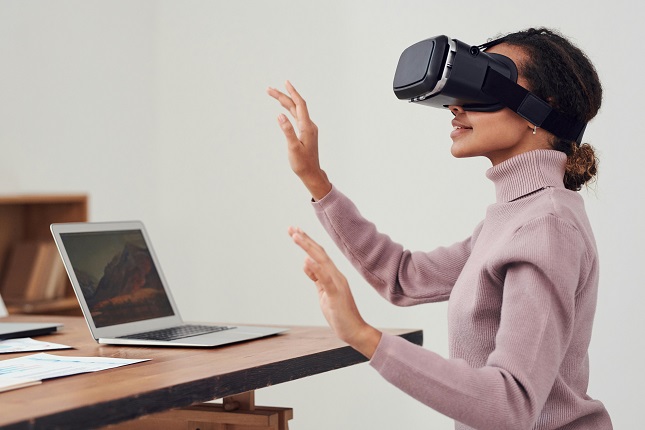In today’s fast-evolving work environment, continuous learning is no longer a luxury—it’s a necessity. As traditional corporate training methods face challenges in engagement and knowledge retention, immersive technologies like Virtual Reality (VR) and Augmented Reality (AR) are emerging as transformative tools in corporate upskilling. These technologies offer an interactive and realistic learning experience that can significantly enhance performance, engagement, and long-term skill retention.
In this article, we explore how businesses can harness the power of VR and AR to revolutionize learning and development strategies.
What Are VR and AR in the Context of Learning?
Virtual Reality (VR) creates a fully immersive digital environment where learners can interact with objects, people, and situations that simulate real-world experiences.
Augmented Reality (AR) overlays digital information (like text, images, or data) onto the physical world through devices like smartphones or smart glasses.
Both technologies are increasingly used in professional development, simulating scenarios that are expensive, dangerous, or impractical to replicate in person.
Why Traditional Training Falls Short
Most corporate training still relies on lectures, slideshows, or static e-learning modules. While these approaches can deliver information, they often struggle with:
- Low engagement: Learners tune out or passively consume information.
- Poor retention: Without hands-on experience, only 10–20% of material is retained after a week.
- Limited scalability: Practical, hands-on training in person is expensive and difficult to scale globally.
Immersive technology addresses all of these shortcomings—and more.
How VR & AR Transform Upskilling
1) Enhanced Engagement Through Interactivity
Interactive environments keep learners active, not passive. For example, VR safety training for manufacturing employees allows them to navigate virtual factories, identify hazards, and practice emergency procedures. Because it feels like real-life experience, learners stay engaged and focused.
2) Increased Knowledge Retention
Studies show that immersive learning can increase knowledge retention by up to 75%, compared to 10% for traditional reading or lecture-based methods. Simulating a sales call in VR or layering customer data insights in AR makes abstract concepts more tangible and memorable.
3) Safe Practice in High-Risk Situations
In fields like healthcare, aviation, or engineering, employees can practice complex or high-risk procedures in a zero-consequence environment. For example, a new airline mechanic can assemble a jet engine virtually—without touching a real one.
4) Personalized, On-Demand Learning
AR-enabled mobile devices or VR headsets can deliver training modules anytime, anywhere. Employees can repeat simulations as needed, review mistakes, and improve at their own pace, which supports diverse learning styles and paces.
Real-World Business Use Cases
Walmart uses VR to train staff for Black Friday by simulating customer surges, noise, and decision-making under pressure.
UPS trains new delivery drivers in virtual environments where they navigate busy streets and identify safety risks.
Boeing uses AR smart glasses to overlay wire schematics on real aircraft, speeding up assembly tasks by 25% and reducing error rates.
These examples highlight not just innovation, but measurable improvements in performance and efficiency.
Integrating Immersive Tech into Your Learning Strategy
To implement VR or AR effectively in your corporate training program:
– Start with High-Impact Areas
Focus on roles or skills where mistakes are costly or training is hard to scale, such as customer service, technical repair, or safety procedures.
– Partner with Specialist Providers
Developing quality VR/AR content requires expertise. Many companies now offer customizable platforms for corporate training.
– Track Progress and Outcomes
Use learning analytics to assess performance, completion rates, and post-training retention. This helps optimize programs and demonstrate ROI.
– Explore Funding and Incentives
Many organizations overlook government programs that support innovation in training. For example, companies investing in immersive learning may qualify for incentives like the research and development tax credit, which can offset development costs for qualifying activities.
Challenges to Consider
While the benefits are compelling, there are still hurdles to adoption:
- Cost: Upfront investment in hardware and content development can be significant.
- Technical Barriers: Not all employees may be comfortable with wearable tech.
- Content Updates: Rapidly changing procedures or regulations require regular content updates to stay relevant.
Fortunately, the cost of VR and AR is decreasing, and more cloud-based solutions are easing the adoption curve.
Looking Ahead: A Smarter Way to Upskill
As hybrid work models and global teams become the norm, immersive learning ensures consistent, effective training across locations and time zones. VR and AR enable companies to prepare employees for real-world tasks more efficiently, safely, and engagingly than ever before.
By embracing immersive technologies, forward-thinking organizations are not just upgrading their training methods—they’re redefining the future of workplace learning.






































